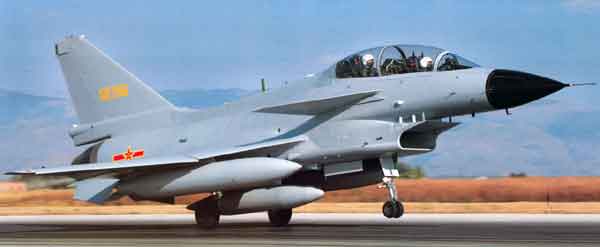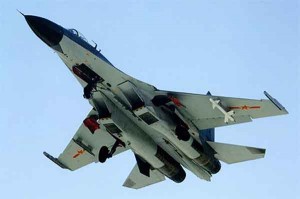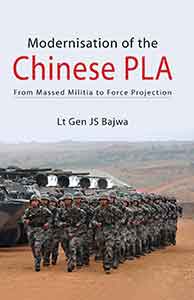Of all the PLA, PLAAF has been the slowest to modernize. In many respects this is linked to its history. The air force’s close identification with Minister of Defense Lin Biao and leftist radicals during the Cultural Revolution left it politically suspect afterwards. China’s domestic turmoil in the aftermath of Lin Biao’s death in 1971 shredded the PLAAF officer corps and severely disrupted the country’s aviation manufacturing infrastructure.
In essence, the Cultural Revolution cost the PLAAF almost two decades of development and sharply diminished its political influence. This, in turn, hampered its technological development.50
Currently, the Air Force has an estimated strength of 3,520 combat aircraft, organized into 100 regiments of fighters and about 12 regiments of tactical bombers plus reconnaissance, transport and helicopter units.
The principal role of the Air Force has been the defense of the Chinese mainland. This did not stretch the existing inventory or infrastructure beyond its limited capabilities. But the primary trend in the development of the PLAAF force structure in this century was summed up by its commander Liu Shunyao as a “switch over of the air force from air defense to combined offensive and defense”.51
Administratively, the PLAAF’s chain of command is organized into four levels: Headquarters Air Force; seven Military Region Air Force (MRAF) headquarters; air corps and command posts; and operational units (organized into divisions, regiments, groups, squadrons, and associated maintenance, logistics and support units). Headquarters Air Force is organized administratively into four major departments (first level) — general staff, political, logistics, and armament departments. The PLA’s MR/MAC headquarters is responsible for combined operations and the AF commander at this level is also the MR/MAC deputy commander.
Currently, the Air Force has an estimated strength of 3,520 combat aircraft, organized into 100 regiments of fighters and about 12 regiments of tactical bombers plus reconnaissance, transport and helicopter units. The equipment in service includes J-6 (Mig-19), J-7 (Mig-21) interceptors, Q-5 (evolved from Mig-19) fighter-bombers, H-5 (IL-28) bombers, H-6 (TU-16) strategic bombers and J-8 (I and II) locally developed fighter of which 100 are in service. Production of the indigenously developed fourth generation combat aircraft J-10 is reportedly progressing well with the first aircrafts being inducted into PLAAF in 2005. The Chengdu factory manufactured J-10 reportedly has a fair share of foreign components, namely, Israeli avionics, Russian engines (AL-31FN turbofan), European landing gear etc. The Al-31FN engine is eventually to be replaced by the indigenous WS-10A turbofan engine.52
The PLAAF’s weapon systems are a combination of old, modified, and new aircraft, and air defense (SAM and AAA) systems. According to senior Chinese officials, there are three types of fighter aircraft being prepared for operational service, including the upgraded J-7 (license built Mig-21) airframe, the J-8 III (combat radius 800 km) and the complete new J-9.53 In July 1998, Russian and Chinese defense officials agreed to cooperate in joint research, development and production of military equipment. PLAAF is reported to have acquired a total of 76 Su-27 fighter aircraft directly from Russia with another 80 being manufactured under license production. The first J-11 (Su-27) aircraft built in China was test flown in January 1999.54
The degree to which technology doors are open for the PLA, particularly from Russia, give ample reason to believe that if Russia has it today, it may be on sale to the PLA tomorrow.
Between 2000 and 2002, PLAAF received a total of 76 Su-30 MKK. The Su-30 aircraft will be armed with AA-11/R-73 SRAAMs, AA-12/R-77 active radar BVRAAMs, AS-17or Kh-31 A1 ASMs, AS-17/Kh-31P-1 Anti Radiation Missiles (ARM), AS-18/Kh-59MK ASMs, AA-10/R-27 and R-27E BVRAAMs. There are also reports that Russia has supplied China with the RVV-AE/R-77 (AA-12 Adder) air-to-air missiles giving PLAAF a significant air combat capability.55 The Su-30 has a stronger air-to-surface operation capability than the Su-27. It indicates its aim to enhance the PLAAF’s ground and ship-attack capability, as well as enhance its all-weather strike capability. The procurement from Russia of the supersonic AS-17 “Krypton” (Kh-31) anti-radiation missile and the AA-10 “Alamo” (R-77) long-range self-guided air-to-air missile as part of the Su-27 deal gives the necessary impetus for the PLAAF’s modernization. It is assessed that by 2010, the PLAAF’s fighter force will most likely consist of between 1,500 and 2,000 aircraft. Almost the entire J-6 and early model J-7s would have been phased out and the remaining force will be of modified J-7s and J-8s, J-9, J-10, J-11 (indigenous Su-27s) and Su-30s. Its first indigenously designed combat aircraft (JH-7 and JH-7A attack aircraft) has entered service in 2005.56
The latest version, the J-8 III is believed to have fly-by-wire controls and an Israeli Aircraft Industry supplied fire-control radar.57 China has successfully mastered the licence production of various components of European helicopters like Dauphin 2 and an indigenously designed multi-role helicopter, the Z-10 is under development.58
According to a Jane’s Defense Weekly article, the PLAAF has also operationally deployed its first generation of locally developed long-range ELINT aircraft in early 1999. According to the report, “four modified TU-154 aircraft, fitted with radomes, have been deployed in the Nanjing MR.” In 1990, the PLAAF upgraded its defense (non-aircraft) capabilities. This involved three of its branches: SAM, AAA, and radar troops. PLA identified the likely problem areas in an article in Jiefangjun Bao, dated July 14, 1998. The article stated that:
“Air battles in the 21st century will be a form of combat which shows Information Warfare at its highest. In order to seize superiority in information, the attacking side will adopt electronic suppression, electronic deception, and route selection to prevent the defensive side from reacting on time. Stealth planes, in particular, will gently reduce the detection range. The PLAAF will have to advance its air defense early warning equipment in order to be able to detect invading targets early, extend for early warning range, and seize the necessary time and space for fighting air defense battles.” 59
The degree to which technology doors are open for the PLA, particularly from Russia, give ample reason to believe that if Russia has it today, it may be on sale to the PLA tomorrow.60 Some of the advanced technologies that are under development for the PLAFF are discussed in the following paragraphs.
Introduction of the Su-30 MKK with Russian Precision Munitions Guidance (PMG) will mark a greater supporting role for lasers in the PLAFF.
Lasers. Research in laser technology for multiple uses of lasers ranging from targeting, radar, communications and kill weapons is under way. But currently, lasers do not have a major role in the PLAAF. The limited use of the lasers is for laser-illumination of a target with the help of an early indigenous laser-guided bomb and to trigger some short-range AAM warheads. Introduction of the Su-30 MKK with Russian Precision Munitions Guidance (PMG) will mark a greater supporting role for lasers in the PLAFF. The use of lasers as kill weapon is suggested by Pentagon’s report since 1998 that the PLA may be using lasers to dazzle low-orbit imaging satellites.61 Also reports indicate that Russian may have sold nuclear-pump laser technology to China. In the 1980’s, the Russian Beriev Bureau modified an IL-76 to carry a large airborne laser. This aircraft, called the A-60 represents one kind of advanced kill laser technology that could be made available to the PLAAF.62
Stealth and Counter-stealth. The PLA is devoting great resources to the development of both stealth and counter-stealth technology to enhance its offensive capability. At the 1998 Zhuhai Air Show, the Seek Optics Company displayed information of its stealth coating and software for stealth shaping.63 There is some report that a new variant of the JH-7 fighter-bomber will incorporate stealth coatings. Also being marketed at this show was the J-231 mid-range surveillance radar having “high anti-stealth capability,” made by the Institute No. 23 of the former China Aerospace Corporation. Reports speculate of a new Russian-Chinese stealth fighter program and that China is interested in purchase of the new Su-32 long-range strike fighter aircraft. With aerial refuelling the Su-32, or the Su-30 for that matter, could undertake armed long-endurance patrols over the South China Sea, or strike out to the “Second Island Chain.”64 China has conducted a test run for its latest stealth aircraft J-20 on January 5, 2011 and is dated to be operational by 2017. The J-20 is a single-seat, twin-engine aircraft. ** There is reportedly a fifth generation stealth aircraft also under development, named the XXJ-1, which is expected to enter operational service by 2015.65
UAVs. PLA had reportedly acquired some number of the very potent anti-radar strike UAV, the Israeli made Harpy in 1994 and some of these have been sent back in 2004 for upgrading with the latest capabilities like striking the target even after switching off the emitter. There is Chinese TV report of a few F-7 aircraft that have been turned into drones possibly for air combat training. For the Army, the PLA fields a series of propeller-driven target drones. The AN-206 drone revealed in the mid-1990s, is a first generation short range tactical reconnaissance drone that apparently has been developed from Israeli technology. China views UAVs as a key future technology. The Zhuhai 1998 Show featured the Chang Chun Institute of Emulation Technology and its virtual reality control systems, a technology often associated with future advanced unmanned combat air vehicles (UCAVs), indicating another area of interest.66
Anti-air Challenge. All of the combat services are devoting greater attention and resources to the anti-air challenge. It is believed that only one or two types of air defense missiles are not enough to form a reliable air defense system under the circumstances of strong electronic jamming. Therefore, the PLAFF is trying to enhance the development and deployment of ground-to-air missile systems in a big way. It is hoped that a multi-tiered air-defense fire network will be established.67 There is also a potential for depth active defense of a new SRBM and land-based LACMs. The PLAFF has since the 1990’s acquired two regiments of Russian Fakel S-300 PMU (SA-10), and one regiment of Almaz Tor M1 (SA-15) which was designed to protect the S-300. Negotiations for additional two S-300 regiments and one Tor-M1 were reported. These systems represent a generation advance over the HQ-2 (SA-2), which itself has been progressively improved.








Living in France is one thing desired by many individuals. If you want to live in France then you have to get French property. You can read the advertisement section of the newspapers which has the section of houses for sale in France. After making a suitable choice, you should research about the properties for sale in France. French property is now a days very much wanted also.
If you want to live in France and spend your life there you should select a proper house. French property is not cheap and you need to make a major investment. You must also know about the properties for sale in France at various locations. The houses for sale in France come in different prices depending on the location
A very infomative & revealing article. Anyone who thinks that Russia is a ” TRUE & RELIABLE ” Friend of India should read his article..It is the Russians who are Upgrading & modernising the Chinese air Force in a Big way-With complete Transfer of Latest Technology.